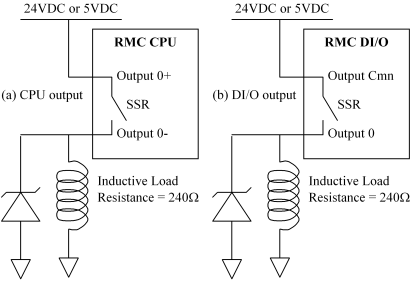
Digital Outputs
The outputs from the Digital I/O’s are solid state relays (SSRs). When they are ”off” they have high impedance, and when ”on” they have low impedance (50 W maximum, 25 W typical). Because the outputs are isolated, the user must power them externally. The maximum current and voltage for the outputs is 100 mA and 30 V.
Each CPU digital output has a + and - connection. Both lines must be connected for the output to function. Because both sides of the output are provided, the switches may be independently connected in a high side or low side configuration (that is, with the load (input) on the source or sinking side of the output). See the wiring diagrams below.
There are nine pins on the ”OUTPUTS” section of the Digital I/O. The bottom pin is marked ”Output Cmn” and is common to one side of all the output relays. The other side of the eight SSRs are numbered 0-7.
The switches can be wired in a high-side or low-side configuration. A high-side configuration ties ”Output Cmn” to the output power source; the SSRs control power to the load. A low-side configuration ties ”Output Cmn” to GND.
Digital Output Wiring Diagrams
External Fuses should be used to protect the SSRs if there is a possibility of over-current. When switching inductive loads, it is important to place a diode or tranzorb across the load to protect the switch when transitioning from an ”on” to an ”off” state. Otherwise, the collapsing magnetic field can cause a reverse voltage spike in excess of the 30 V rating of the SSR. See figures below for detail.

Figure #1: SSR switching inductive load; high-side configuration
To calculate the maximum current through the SSR in the above diagram, we assume zero SSR resistance:
Max. current = 24V / 240W = 100mA
Max. current = 5V / 240W = 20.8mA
In the 24V case, the maximum current is right at the maximum allowed by the SSRs. The outputs may be overpowered if the coil resistance is reduced further. To calculate the typical current through the SSR, we use the typical SSR resistance of 25W:
Typical current = 24V / (240W + 25W) = 90.6mA
Typical current = 5V / (240W + 25W) = 18.9mA
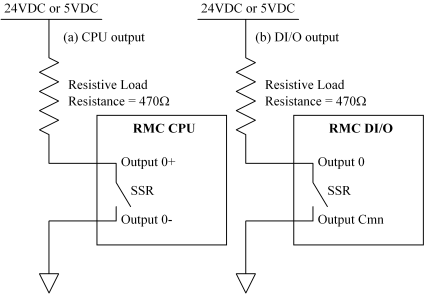
Figure #2: SSR switching resistive load; low-side configuration
To calculate the maximum current through the SSR in the above diagram, we assume zero SSR resistance:
Max. current = 24V / 470W = 51.1mA
Max. current = 5V / 470W = 10.6mA
Notice that both maximum current are well within the ratings. To calculate the typical current through the SSR, we use the typical SSR resistance of 25W:
Typical current = 24V / (470W + 25W) = 48.5mA
Typical current = 5V / (470W + 25W) = 10.1mA
Digital Inputs
The Digital Inputs are compatible with signal levels ranging from 5V to 24V. The Digital inputs draw 6mA maximum with a 5V input and 10mA with a 24V input.
Each of the CPU’s two inputs have both a + and - connection. This allows the input to be connected as either a sinking or sourcing input, which means that most P/C outputs can be connected directly to the CPU inputs. See the wiring diagrams below.
The DI/O inputs consist of a single common and eighteen individual input connections.
Note: The numbered inputs must be positive relative to the ”Input Cmn” pin common. That is, these are sinking inputs.
Most P/C outputs can be connected to the DI/O inputs directly. The exception is open collector (sinking) outputs. See the discussion below for using sinking outputs.
Note: Because the inputs are designed for use with 5V outputs, the threshold is 2.75VDC. This is a small percentage of the 24V output. As a result, it is important that the inputs have very little noise. If noise is a problem, we recommend that the wiring be rearranged so the noise in the wires is reduced. If this is not feasible, try using the software input filters, or you may want to consider using a voltage divider on the inputs. This is described below.
Digital Input Wiring Diagrams
The following are some input wiring diagrams:
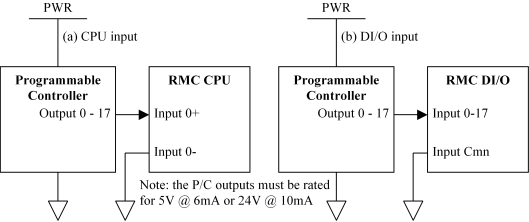
Figure #3: Direct connection to Programmable Controller
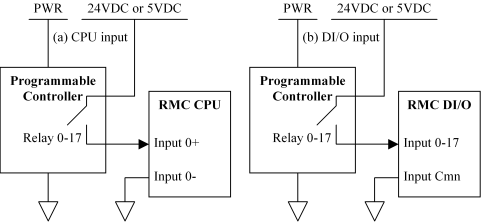
Figure #4: Relay Connection from Programmable Controller
The RMC’s CPU inputs can also be connected directly to open collector (sinking) outputs. DI/O inputs cannot be connected directly, as described below.
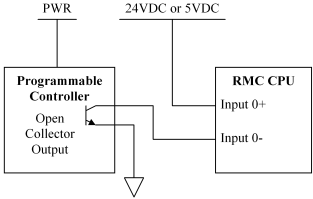
Figure #5: Open Collector Outputs to RMC CPU Inputs
The RMC’s DI/O inputs are not optimized for use with open collector (sinking) outputs. The difficulty arises from the fact that sinking outputs have a common ground, but the DI/O also needs a common ground. Therefore, pull-up resisters must be used, as shown in the following diagram (resister values are described below):
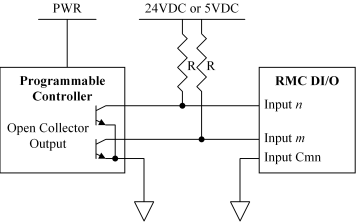
Figure #6: Open Collector Outputs to RMC DI/O Inputs
For 24VDC power, R should be a 3.3 kOhm, ½ watt resister. The output must be capable of switching 7.5mA when closed. When open collector output is open, the DI/O input sees 7V @ 5.1mA.
For 5VDC power, R should be a 560 Ohm, 1/8 watt resister. The output must be capable of switching 9.0mA when closed. When open collector output is open, the DI/O input sees 3.1V @ 3.4mA.
Dividing the Input Voltage
Because the inputs are designed for use with 5V outputs, the threshold is 2.75VDC. This is a small percentage of the 24V outputs. As a result, it is important that the inputs have very little noise. This section describes using a voltage divider to raise the apparent input threshold.
Note: Before resorting to dividing the input voltage, take all possible measures to eliminate noise from the inputs. Also, you may want to employ the software input filters.
To divide the inputs, attach resisters to each input as shown in the following diagram:
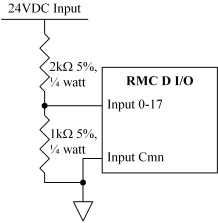
This configuration will reduce noise susceptability by a factor of about five.
See also:
kadov_tag{ {
Copyright (c) 1997-2015 by Delta Computer Systems, Inc.